Every Sunday morning in Bataan, I wake up early to catch fresh crabs along the shore of Manila Bay. It's one of my favorite things to do, just walking in the shallow water with my net, watching the small blue crabs (alimasag) scurry around in the sand. These crabs are perfect for one of my all-time favorite Filipino dishes: Ginataang Kamansi at Alimasag.
This recipe combines tender crab meat with kamansi (breadnut) cooked in creamy coconut milk. Don't worry if you've never cooked with kamansi before, it's actually easier to prepare than jackfruit. The kamansi grows everywhere in our province, and when mixed with gata (coconut milk) and crab, it creates a rich, comforting dish that tastes like home. This recipe is simple to follow and absolutely delicious with hot rice.
Cultural Notes
Ginataang Kamansi at Alimasag is a traditional Filipino dish that showcases the versatility of local ingredients. The combination of kamansi and crab in coconut milk represents the abundance of coastal and inland resources in Philippine cuisine.
Jump to:

Why You'll Love This Recipe
- Authentic Filipino flavors combining the unique taste of breadnut with sweet crab meat
- Rich, creamy coconut sauce that perfectly complements both ingredients
- Healthy and nutritious - perfect for breastfeeding mothers
- One-pot meal that's both comforting and special enough for gatherings
- Budget-friendly yet impressive dish
Ingredients
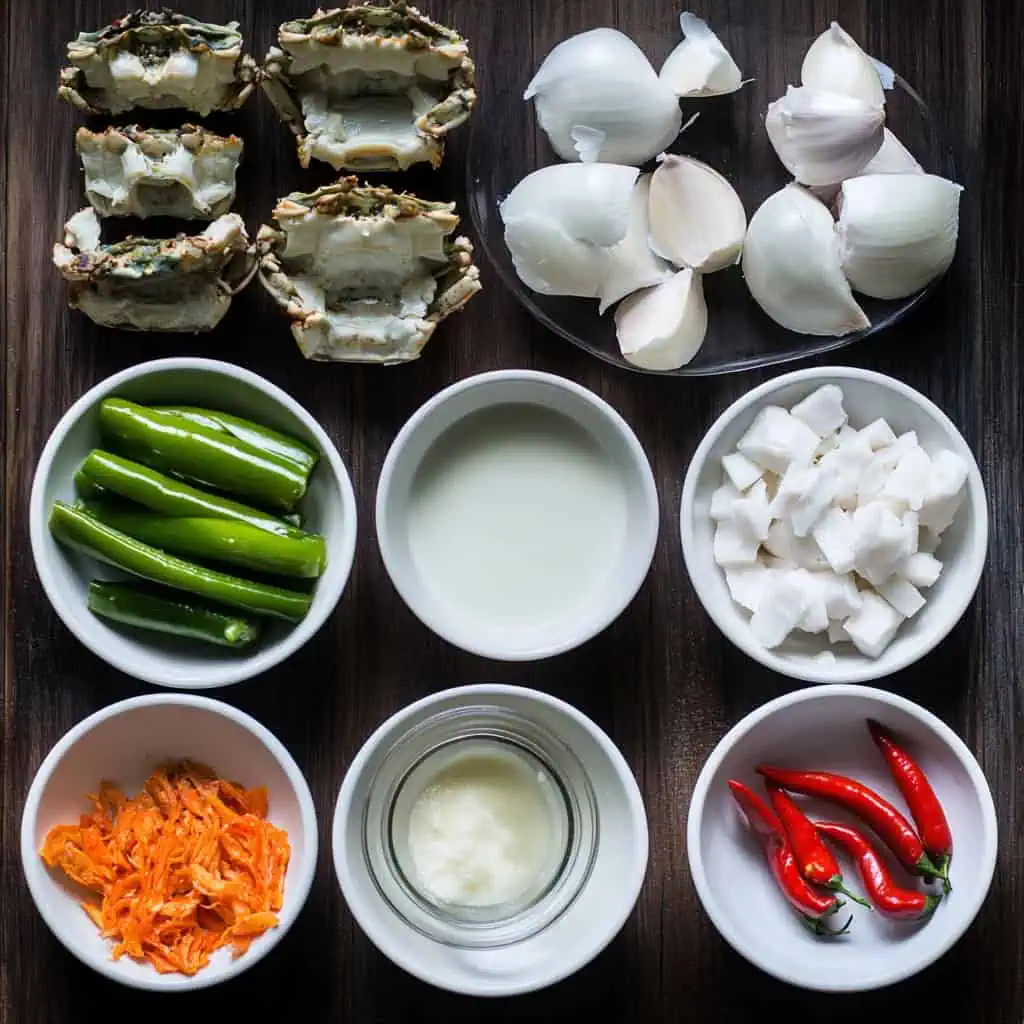
- 3 pieces kamansi/breadnut, peeled and cut into bite-size pieces
- 6-7 pieces blue crabs (alimasag), cleaned and halved
- 2 cups thick coconut milk (kakang gata)
- 5 cups thin coconut milk (gata)
- 1 medium onion, chopped
- 4 cloves garlic, minced
- 1 thumb-size ginger, grated
- 3 tablespoons cooking oil
- 4 pieces bird's eye chili (siling labuyo), cut
- 4 tablespoons fish sauce (patis)
- Salt and pepper to taste
Equipment
- Large Wok or Deep Pan (kawali) - For even heat distribution and sufficient space to accommodate all ingredients without overcrowding
- Sharp Knife - Essential for peeling the tough outer skin of kamansi and cutting it into even, bite-sized pieces
- Wooden Spoon - Allows for gentle stirring without breaking the delicate crab pieces or kamansi
- Grater - Used for finely grating ginger and optionally for fresh coconut if making homemade coconut milk
- Strainer - Helpful when extracting fresh coconut milk or straining impurities
- Measuring Cups and Spoons - For accurate measurements to ensure balanced flavors
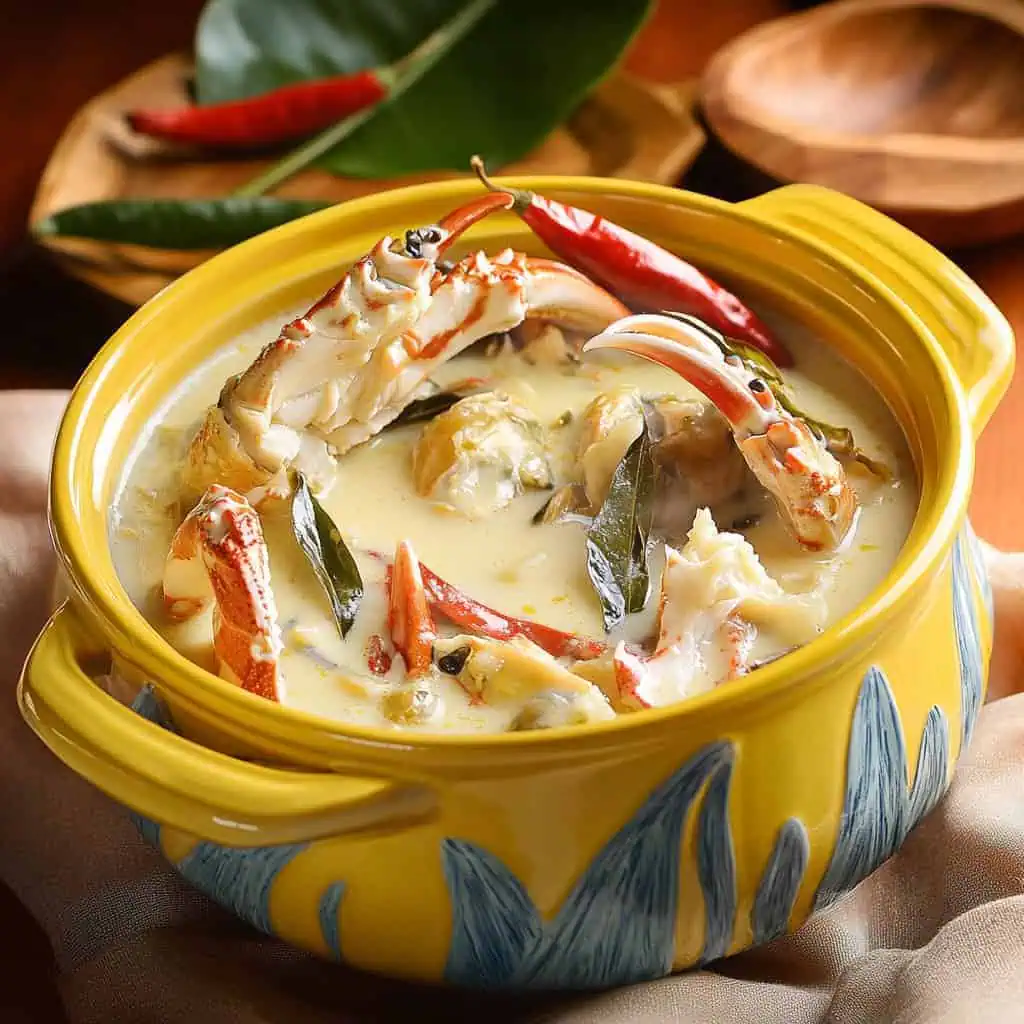
How To Make
- Prepare the coconut milk (if using fresh coconut): Combine 2 cups of warm water (35°C) with freshly grated coconut and squeeze well to extract the thick coconut milk (kakang gata). Set aside. Take the same coconut meat, mix with 5 cups of warm water, and squeeze again to get your thin coconut milk. Set both aside separately.
- Sauté the aromatics: Heat 3 tablespoons of oil in a large pan over medium heat (180°C). Add minced garlic, chopped onions, and grated ginger. Cook until onions become translucent and the mixture is fragrant, about 3-5 minutes.
- Cook the main ingredients: Add the cleaned crabs to the pan along with all of the thin coconut milk. Add the peeled and cut kamansi pieces. Simmer gently over medium-low heat (160°C) until the kamansi is fork-tender but still holds its shape, about 20-25 minutes.
- Add the thick coconut milk: Pour in the reserved thick coconut milk and add the fish sauce. Lower the heat (140°C) and simmer for 5 more minutes until the sauce thickens slightly. You'll know it's ready when tiny pools of oil form on top of the coconut milk (called langis-langisan).
- Season to taste: Adjust the flavor with salt and pepper. For heat, add the cut bird's eye chilies. Give everything one final gentle stir.
- Serve: Enjoy your ginataang kamansi at alimasag hot with plenty of steamed rice. For the authentic experience, enjoy it kamayan style (with your hands).

Tips from Lola's Kitchen
- Choose young kamansi for a more tender texture and milder flavor
- Test kamansi ripeness by gently tapping it – a hollow sound indicates it's ready to use
- Clean crabs thoroughly by scrubbing with salt water to remove any dirt and impurities
- Control the heat when cooking with coconut milk – too high heat can cause curdling
- Add coconut milk gradually and stir gently to prevent separation
- Add chilies at the end so you can control the spiciness level
- Let the dish rest for 5-10 minutes before serving to allow flavors to meld together
- When cutting kamansi, coat your knife and hands with a little oil to prevent stickiness
Substitutions
- Fresh coconut milk → Canned coconut milk: Use a 1:1 ratio, diluting as needed to achieve the right consistency
- Kamansi → Young jackfruit or breadfruit: While the flavor will be slightly different, both make excellent substitutes
- Blue crabs → Shrimp or white fish: These seafood alternatives work well with the coconut base
- Bird's eye chili → Long green chilies: For a milder heat that's more family-friendly
- Fish sauce → Salt: If fish sauce is unavailable, though you'll miss some of the umami depth
- Fresh ginger → Ginger powder: Use 1 teaspoon of powder for every thumb-sized piece
Troubleshooting
- Sauce is too thin: Simmer longer without a lid to reduce the liquid, or add a tablespoon of rice flour mixed with water
- Kamansi is too firm: Continue cooking until fork-tender before adding the thick coconut milk
- Sauce is too spicy: Add more coconut milk to dilute the heat or serve with extra rice and a side of cucumber
- Coconut milk curdled: Lower heat immediately and stir gently. Next time, keep heat lower and avoid boiling
- Crabs are tough: They were likely overcooked. Crabs cook quickly, so add them later in the process if this happens
- Dish is too salty: Add a peeled, quartered potato to absorb excess salt, or dilute with additional coconut milk
Storage & Reheating
- Refrigerate in an airtight container for up to 2 days
- Not recommended for freezing as coconut milk can separate and the texture of both kamansi and crab will deteriorate
- Reheat on stovetop over low heat (120°C) to prevent coconut milk from separating
- Add a splash of fresh coconut milk when reheating to revive the creamy texture
- Stir gently while reheating to preserve the integrity of the ingredients
- Consume leftovers promptly as seafood dishes have a shorter shelf life
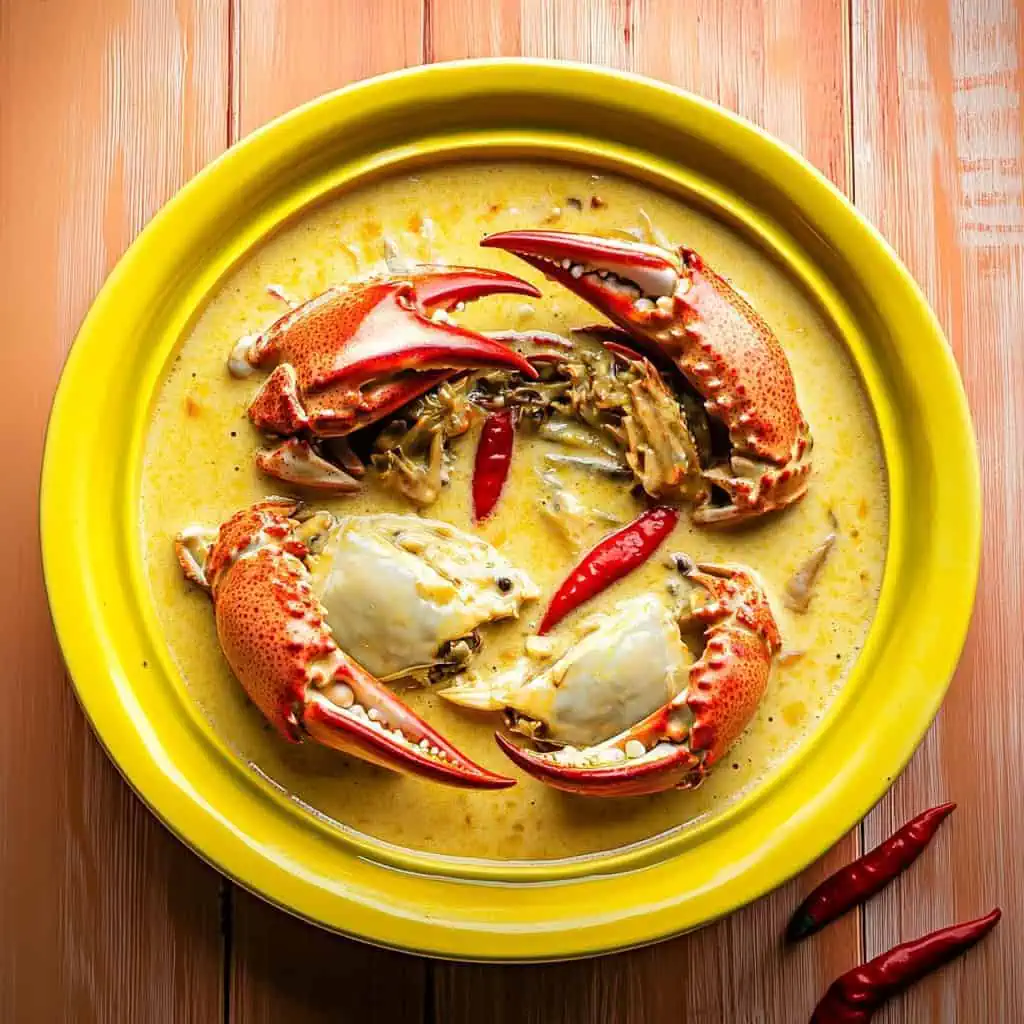
FAQ
How do I select the best kamansi?
Choose firm, green fruits without dark spots. Younger, smaller kamansi are best for this dish as they're more tender and less fibrous.
Can I make this dish less spicy?
Absolutely! Reduce or completely omit the chilies. The dish remains flavorful from the aromatics and coconut milk.
How do I know when the kamansi is properly cooked?
It should be easily pierced with a fork but still hold its shape. Overcooked kamansi becomes mushy and loses its texture.
Can I use ready-made coconut milk?
Yes, use 2 cans (400ml each) of coconut milk. Dilute one can with water for the thin milk and use the other undiluted for the thick milk.
Is there a vegetarian version of this dish?
Yes! Replace the crab with mushrooms (oyster or king) and use salt instead of fish sauce for a delicious plant-based alternative.
How do I clean crabs properly?
Remove the top shell, discard the gills and intestines, and rinse under cold water. Scrub with salt to remove impurities, then rinse again.
Can I add vegetables to this dish?
Yes, vegetables like eggplant, string beans, or squash make excellent additions.
Why is my coconut milk curdling?
Coconut milk curdles at high temperatures. Keep the heat medium-low and avoid boiling after adding the thick coconut milk.
Related
Looking for other recipes like this? Try these:

Ginataang Kamansi at Alimasag (Breadnut and Crab in Coconut Milk)
Equipment
- Large Wok or Deep Pan (kawali) For even heat distribution and sufficient space for ingredients
- Sharp knife (kutsilyo) For peeling and cutting the kamansi
- Wooden spoon (sandok na kahoy) For gentle stirring without breaking ingredients
- Grater (kudkuran) For coconut and ginger
- Strainer [Salaan] For extracting coconut milk
- Measuring cups and spoons (Panukat) For accurate measurements
Ingredients
- 3 pieces Kamansi/Breadnut peeled and cut into bite-size pieces
- 6-7 pieces crabs Alimasag, cleaned and halved
- 2 cups thick coconut milk Kakang gata
- 5 cups thin coconut milk Gata
- 1 medium onion Sibuyas, chopped
- 4 cloves garlic Bawang, minced
- 1 thumb-size ginger Luya, grated
- 3 tablespoon cooking oil Mantika
- 4 pieces bird's eye chili Siling labuyo, cut
- 4 tablespoon fish sauce Patis
- Salt and Pepper Asin at Paminta to taste
Instructions
- First, combine 2 cups of warm water (35°C) with freshly grated coconut and squeeze well to get your thick coconut milk (kakang gata). Set this aside - you'll use it later. Take the same coconut meat and mix it with 5 cups of warm water, then squeeze again to get your thin coconut milk (pangalawang gata). Set this aside too.
- Heat 3 tablespoons of oil in a large pan or kawali over medium heat (180°C). Add your minced garlic, chopped onions, and grated ginger. Cook these together until your onions become see-through and everything smells fragrant, about 3-5 minutes.
- Now add your cleaned crabs to the pan along with all of the thin coconut milk you made earlier. Add your peeled and cut kamansi pieces too. Let this simmer gently over medium-low heat (160°C) until you can easily pierce the kamansi with a fork but it still holds its shape, about 20-25 minutes.
- Pour in your reserved thick coconut milk and add the fish sauce. Lower the heat (140°C) and let it simmer for 5 more minutes until the sauce thickens a bit. You'll know it's ready when you see tiny pools of oil forming on top of the coconut milk - we call this langis-langisan.
- Taste your sauce and add salt and pepper until you're happy with the flavor. If you want some heat, add your cut bird's eye chilies now. Give everything one final gentle stir.
- Serve your ginataang kamansi at alimasag hot with plenty of steamed rice. For the best experience, enjoy it kamayan style (with your hands) and make sure to have extra rice ready to soak up all that delicious sauce.
Tips from Lola's Kitchen
- Choose young kamansi for tender texture
- Test kamansi ripeness by tapping - it should sound hollow
- Clean crabs thoroughly by scrubbing with salt water
- Don't overcook coconut milk to prevent curdling
- Add chili last to control spiciness
Nutrition
The Story Behind Ginataang Kamansi at Alimasag
In the coastal towns of the Philippines, where coconut trees sway and breadnut trees grow wild in backyards, Ginataang Kamansi at Alimasag tells a story of Filipino resourcefulness and creativity in the kitchen. This hearty dish brings together two ingredients that many Filipinos find right in their own neighborhoods: the often overlooked kamansi (breadnut) and fresh alimasag (blue crabs) from our waters.
Kamansi, often confused with its more famous cousin breadfruit, has been feeding Filipino families for generations. While many think it's the same as langka (jackfruit), this special fruit has its own unique, subtle flavor that really shines when cooked in creamy coconut milk. You'll find these trees growing tall in provinces like Bataan, Laguna, Quezon, and throughout the Visayas, their green fruits often free for anyone who asks their neighbor nicely.
The genius of this dish lies in how it combines land and sea - the kamansi from our gardens and the crabs from our shores. Our ancestors figured out that cooking these humble ingredients in gata (coconut milk) creates something truly special. In many coastal areas, especially in places like Bataan where I'm from, families would catch fresh crabs in the morning and pick kamansi from their trees, creating this dish for lunch using ingredients that didn't cost them anything except time and effort.
What makes this recipe so beloved in Filipino homes is its practicality and flavor. The kamansi soaks up the rich coconut milk like tiny flavor sponges, while the crab meat adds a sweet, delicate taste that makes the dish feel like a real treat. It's the kind of food that reminds Filipinos of Sunday family lunches, where everyone gathers around the table, picking crab meat and scooping up the creamy sauce with mounds of hot rice.
Today, this dish remains a testament to Filipino culinary wisdom - turning simple, local ingredients into a meal that's both filling and special. Whether you're cooking it in a modern kitchen in Manila or over a wood fire in the provinces, Ginataang Kamansi at Alimasag connects us to our roots and reminds us of the incredible flavors we can create from ingredients growing right in our own backyards.
For first-time cooks trying this recipe, you're not just making a meal - you're becoming part of a long tradition of Filipino home cooking that transforms humble ingredients into something extraordinary. And trust me, once you master this ginataan, you'll understand why it holds such a special place in Filipino family kitchens.
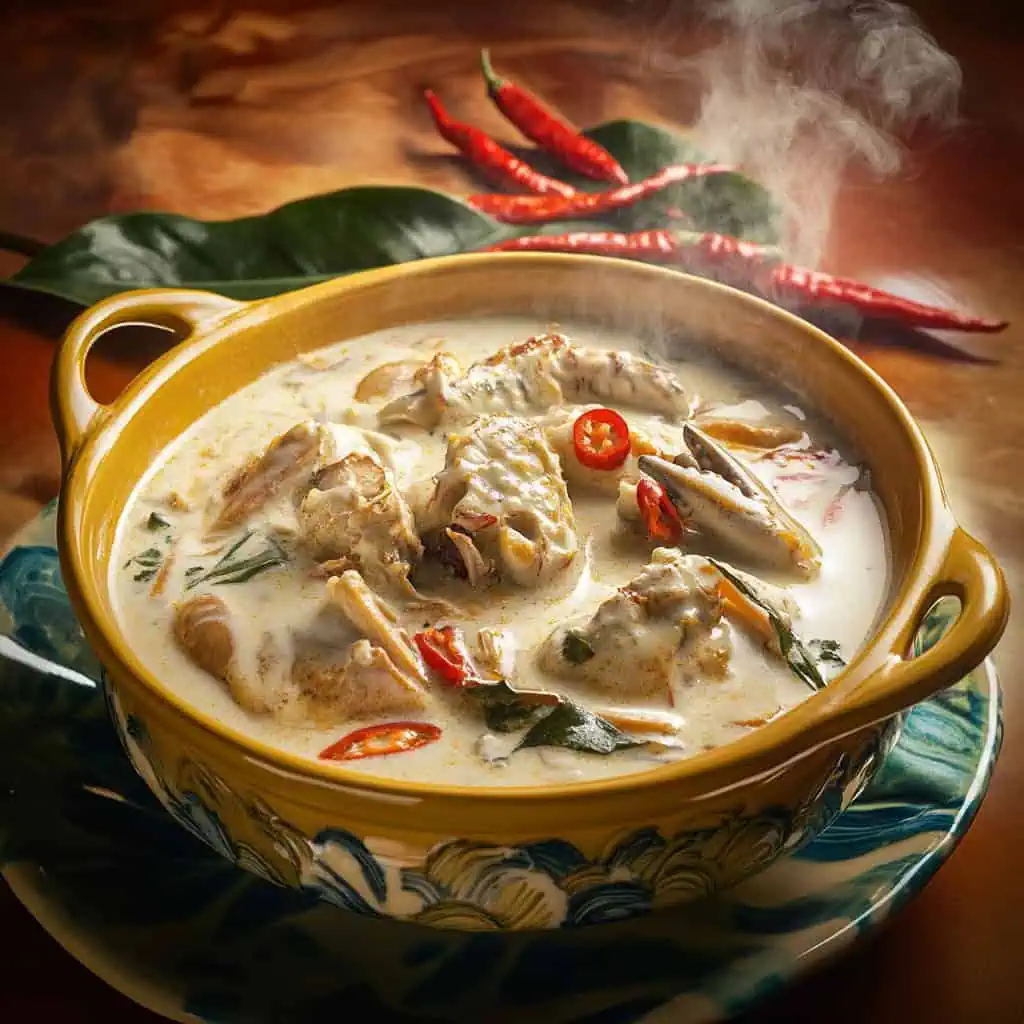








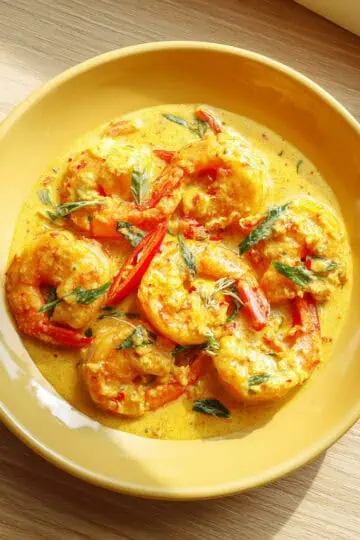
Comments
No Comments